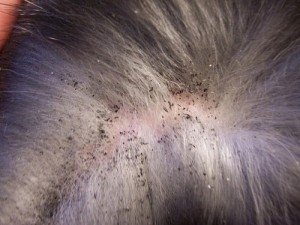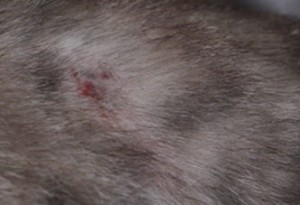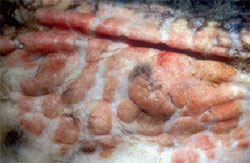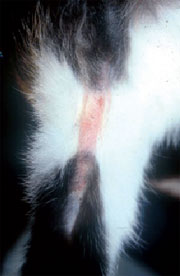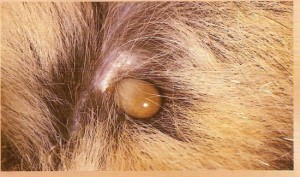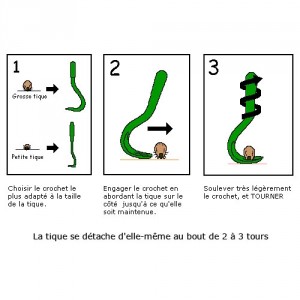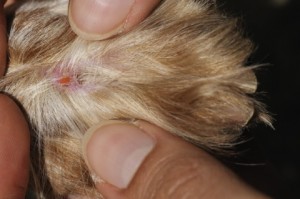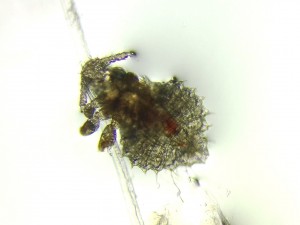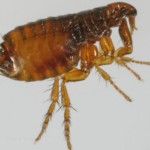
External parasites from pets
The external parasites of dogs and cats
Our pets can be the target of different parasites it is important to know in order to better combat.
.
1/Fleas
.
Fleas are external parasite of dogs and cats the most frequent.
A few figures that make think :
-1 female may lay 50 Eggs per day during 50 to 100 days
-1 chip lives on average 100 days
-the fallen eggs hatch into larvae in 3 to 7 days
-These larvae develop into adult fleas 2 weeks to 1 month (more quickly if animals are present)
-in the absence of animals to stitch, the larvae can survive several months.
The Pulicosis is reflected by the itching, buttons and crusts. It is not always the adult fleas on the animal, but sometimes can identify their droppings which come in the form of small debris (sometimes in the form of comma) Dark/blackish brown color, consisting of digested blood. About cats, which groom themselves much, It may be very difficult to see bullets because they are eaten regularly.
.
The flea allergy dermatitis, caused by saliva, characterized in dogs by itching and lesions at the level of the back, with loins, the tail and the front inner thighs, with sometimes oozing inflammatory reactions very painful. The severity of the symptoms is independent of the number of fleas on the animal: a single flea bite can sometimes cause an impressive clinical.
In cats, There are different clinical forms :
- one alopecia Auto-induite : the cat licks up to crack and lose its hair.
- one Miliary Dermatitis : appearance of buttons and thin crusts more or less important, more commonly observed on the back or neck.
- of noneosinophilic plates: have the appearance of plates embossed, farms, very red, often ulcerated and have an extremely marked inflammatory character.
- one linear Granuloma (noneosinophilic granulomas arranged in a linear configuration, partly caudal hind limbs or more rarely on the neck, the thorax, previous members.
- or at cervico-facial pruritus (itching in the regions of the neck and face).
.
.
They have in addition an indirect role real and misunderstood. They are vectors for internal parasites (Dipylidium caninum for example: the tapeworm), or bacteria as the causative agent of Cat Scratch Disease (Bartonella henselae).
The best treatment is a prevention throughout the year, to avoid an infestation of the external environment. There are different ways of processing to adapt to case by case depending on the number of animals to be treated, the ease of operation of the treatment, their way of life, and whether or not they are allergic to flea bites.
These include treatments in the form of pipettes to apply on the skin of the neck, to external or internal action, from sprays, from shampoos, from tablets, or necklaces. Most associate an action on these fleas on the animal action on the development of the larval stages in the environment. In some cases it may be advisable to specifically treat the environment with fogger. The pace of implementation depends on the symptoms of animals, but in general, It must renew the treatment every month (except for the collar).
.
2/Ticks
.
These are mites that feed on the blood of animals. Found in the herbs and bushes, and multiply at temperatures between 0 ° C and 20 ° C, What explains their presence virtually throughout the year in our temperate regions.
They attach themselves to the skin after will be hung in the fur, and become engorged blood for several days, before you detach to go lay in the external environment. They can transmit potentially serious diseases fatal to cats and dogs:
.
- The Piroplasmosis or Babesiosis :
This disease is linked to parasites (piroplasms) that the tick transmits to the animal when it bites. These parasites destroy its red blood cells : It is the phase of "hemolysis" which can lead to anemia (lack of red blood cells) more or less severe. This hemolysis is toxic to other bodies that show signs of failure (renal failure, liver toxicity...) In the most severe cases, Piroplasmosis may cause the death of the animal.
The classic symptoms of a Piroplasmosis are: fever, abatement, Brown urine.
- Ehrlichiosis
This disease is associated with bacteria (Ehrlichia canis) that the tick transmits to the animal when it bites. It translates into a reduction, fever, joint pain... Blood level, often there is a decrease in blood cells (Red and white blood cells, platelets) by achievement of the bone marrow. In the more severe forms, the animal may die.
. - The Lyme disease or borreliosis :
This disease, common to man and animals, is caused by a bacterium (Borrelia burgdorferi) tick-borne. It can cause an increase in the size of the lymph, renal failure, heart failure, skin problems, nervous... or even the death of the animal.
.
Prevention appears therefore as essential with regard to these diseases to take seriously. The goal is to minimize their attachment, or cause their downfall and death as soon as possible, especially until they have time to inject any pathogen.
For this, There are several products, to choose according to certain criteria : These products must
-Be effective against ticks ! Indeed, some anti-parasitic assets on the chips are not on ticks.
-Have a carryover effect, in general a month, or even several months for necklaces.
-Having good resistance to water.
–Ne be toxic ! Never use of pyrethroids on cats. (ADVANTIX)
.
If you find a tick on your pet, remove the more quickly. A hook provided to safely remove, without running the risk of letting the head. We can sometimes observe a small Granuloma at the place where the tick was attached, What is safe for the animal, and will quickly disappear. On the other hand, If you look at a deduction, a fever, dark urine, contact us more quickly...
.
.
.
3/The chiggers (Trombiculose)
.
It comes seasonal mites whose larvae feed on animals or men. Their life cycle lasts 2 to 12 month. There are several generations of chiggers in the summer, from March to October. The time of the meal is 3 to 4 days. Gulp once, the larva leaves the host to moult in nymph, then in adult. Adults breed and lay eggs at the end of 8-10 days ; they survive several weeks in mid summer, and enter diapause in the late fall to reactivate the following spring. The eggs hatch quickly, releasing larvae fasting, single stage parasite, who are actively seeking hosts for food. They resist several weeks to several months to young.
Contamination is done exclusively from the external environment (Garden, brush, hedges, groves...) more often towards the end of the summer in our regions.
.
Saliva the chiggers is very irritating or allergenic, What causes severe itching, a licking, with erythematous areas and sometimes without hair. If the animal is not much licked, You can see parasites in the form of small bright orange clusters. The preferred locations are : between the fingers, the Auricular pavilions, chops, the armpits, the fold of the groin. The itching persists a few days after the disappearance of parasites.
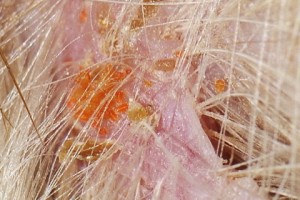
Aoutâts
.
.
.
.
.
.
The most effective treatment is anti-parasitic for shampoos-based dogs only because toxic in cats. For the latter, It uses sprays to spray directly on infested areas. Applications should be repeated during the period at risk.
.
4/ Lice (phtiriose)
.
It comes of chewing or biting insects, that adults cling to the coat with a claw at the end of each leg. They are rather at the base of the hairs on the neck and back, sometimes on the head and the external face of the Auricular pavilions. They are permanent parasites that feed by Sting and ingestion of blood and lymph, or by consuming dander, skin debris. They remain on the surface and can move fairly quickly, What makes their difficult observation.
Females lay at the base of the hairs of the eggs (nits) whitish, the naked fixed. These eggs hatch in 6 days. The duration of the cycle is on average 3 weeks, an adult louse until. Each female lays approximately 300 Eggs and lives 6 to 8 weeks.
The lice fear the cold and heat, they resist shortly in the external environment, 3-4 maximum days, What remains sufficient to contaminate other animals.
Infested animals have a dull coat, dander, papules and crusts, with a variable pruritus.
The treatment is the same as that of fleas, with however more repeated applications (all the 15 days instead of a month, during 4 to 6 weeks). Community or during massive contamination, sometimes can advise the mowing of the animals concerned.
.
There are many other external parasites, as the demodex, galls, the cheyletielles, whose diagnosis and treatment require a consultation and follow-up in-depth. (Click here to learn more)
.
Through this presentation, It can be seen that is common to all these parasites pruritus (itching). Should therefore examine the skin and coat of our animals as they scratch. The key word for external parasites remains first and foremost prevention, using different ways that one will choose on the basis of the animals to be treated, ease of application, pelage, their way of life, etc. while respecting the duration of action the treatment used.

